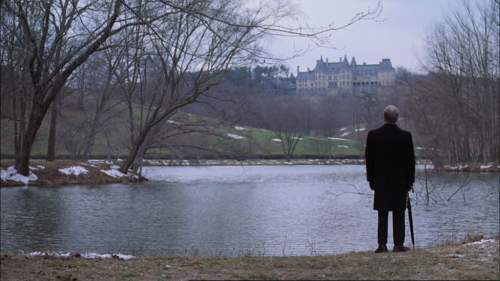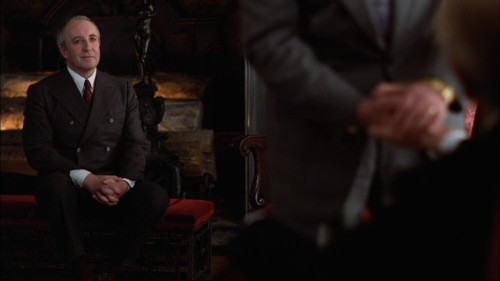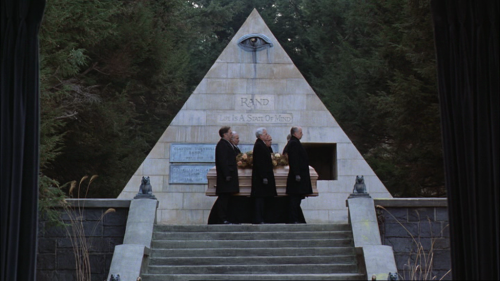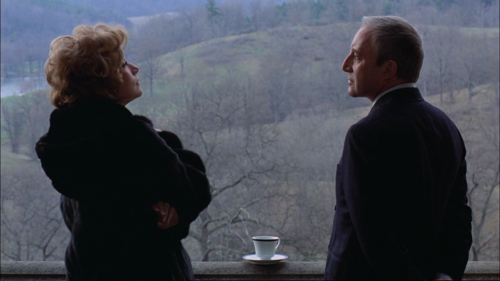Along with Peter Thomson (his blog here), I’ve launched a new screening series at Birkbeck Cinema that will run for the next couple of months, screening films about Houses and Homes every couple of weeks. The full details are below and I’ll be posting the programme notes I’m writing for each film here after the screenings. The first film was Being There.
The first film in this series is a tale of two houses. The first is on screen only for its first part, but casts a shadow across the entire of the rest of it. Chance the Gardner has never been outside the walls of his home in Washington D.C., where he tends to a small walled garden for a Havisham-like aristocrat. His only contact with the outside world is through the television, which he endlessly clicks through the channels on[1]. The other house is the one he comes to inhabit with Ben and Eve Rand after a chance accident. The Biltmore Estate in North Carolina provided the shooting location (now advertised as a tourist attraction: ‘America’s largest home’). Making extensive use of master shots that capture the solidity, space and darkness of the house, Hal Ashby allows it to speak richly of the pomposity of the Gilded Age, and of those who still inhabit its dream of American dynamism against a backdrop of European excess. Truly, it is the bear skin rug that lifts Eve’s ‘moment of passion’ to pure comedy.
Both houses in this film are sites of stasis: in Chance’s point of origin, of a personal stasis; in Biltmore, of class and position. There’s a brief interlude between the two houses that acts as a tunnel between these two fantasies: Washington – looking a lot like the pre-Giuliani New York of Walter Hill’s The Warriors (1979) – is a city of decay and racial cruelty. Luckily, Chance can escape to the place where the life he has lived continues unabated (the scene in which Louise, Chance’s former colleague, watches him ascendant on television is at the centre of the mordant humour/horror of the film).
Chance the Gardener is a highly effective cipher; his transparency is his only quality. Although set in the television age, the picture it paints is of an America which has just emerged from the forge, ripe for moulding to whoever puts their hand to it. Unlike Robert Zemeckis’ Forrest Gump (1994), Chance’s simplicity is not cast as an admirable purity, but a mirror in which the vacuity and insecurity of the world is clear. Like the television he can never watch a single item of for more than 45 seconds, he reflects a different view of himself to whatever the viewer desires. Ashby brilliantly lingers on Chance, caught benignly, but utterly passively watching real life events. He is so used to witnessing life on the television that he never challenges, never speaks unless directly questioned.
Chance holds the same interests as those perennial stories of feral children. Instead of being entirely outside culture, he is entirely a product of the monoculture of television. Unlike Kaspar Hauser[2] Chance is a thought experiment that plays out in his reactions to those around him, rather than in his reactions to culture[3].
This is seen most clearly in the investment those around him place in his speech. Changed by his new context, he becomes laconic rather than imbecilic, and when he does speak, his words are invested with false solemnity. His garden ‘analogy’ becomes a satire on a very particular kind of American speechifying: partly influenced by the Transcendental movement and its predilection for abstruse analogy, but also beloved by politicians, it is shy on troubling and divisive details; the aim is to fool all of the people all of the time. Chance’s actions are meaningless imitation – he has no sense of the function or value of what he says or does. In an early moment, we see him dusting the long-flat tires of his benefactor’s ancient town car. This kind of superficiality is a dark comment on the glance that television demands from us – of unquestioned viewing without consideration.
The film proved curiously elegiac for many involved. Although Being There was not quite Peter Sellers last released film,[4] it’s too perfect an end for the actor not to remember it so. It’s an easy film to mythologise in this sense: Sellers, the lifelong chameleon, permitting himself to drop the mask before dying to show what is beneath his characters – nothing at all. Hal Ashby’s[5] string of successes came to an end with this film and it is also one of Golden Age star Melvyn Douglas’ final films (benign and charming even as the GOP-boosting Ben Rand). It’s fitting then that the film ends with transcendence rather than a destructive whirlwind of other arch satires in this mould (Dr. Strangelove (1964) for example). Rather than offer Chance merely as a means of symptomising the stupidity of the world, he is also emblematic of its possibilities as long as we accept that ‘Life is a state of mind.’
[1] Besides being a general satire on the television age, Being There also comments on the rise of the television remote, which, to accommodate teletext, was becoming more complex and ubiquitous.
[2]A story filmed by Werner Herzog (a man whose career has been shaped by trips into the uncivilised) as The Enigma of Kasper Hauser (1974) or, more wonderfully, under its German title Jeder für sich und Gott gegen alle [Every Man for Himself and God Against All].
[3] Many of the roles of Robin Williams’ early career could be seen as the product of a man entirely under the influence of a channel-hopping television.
[4] The less said about the ignominious The Fiendish Plot of Dr. FuManchu (1980), the better.
[5] Watch out for his news room cameo.








